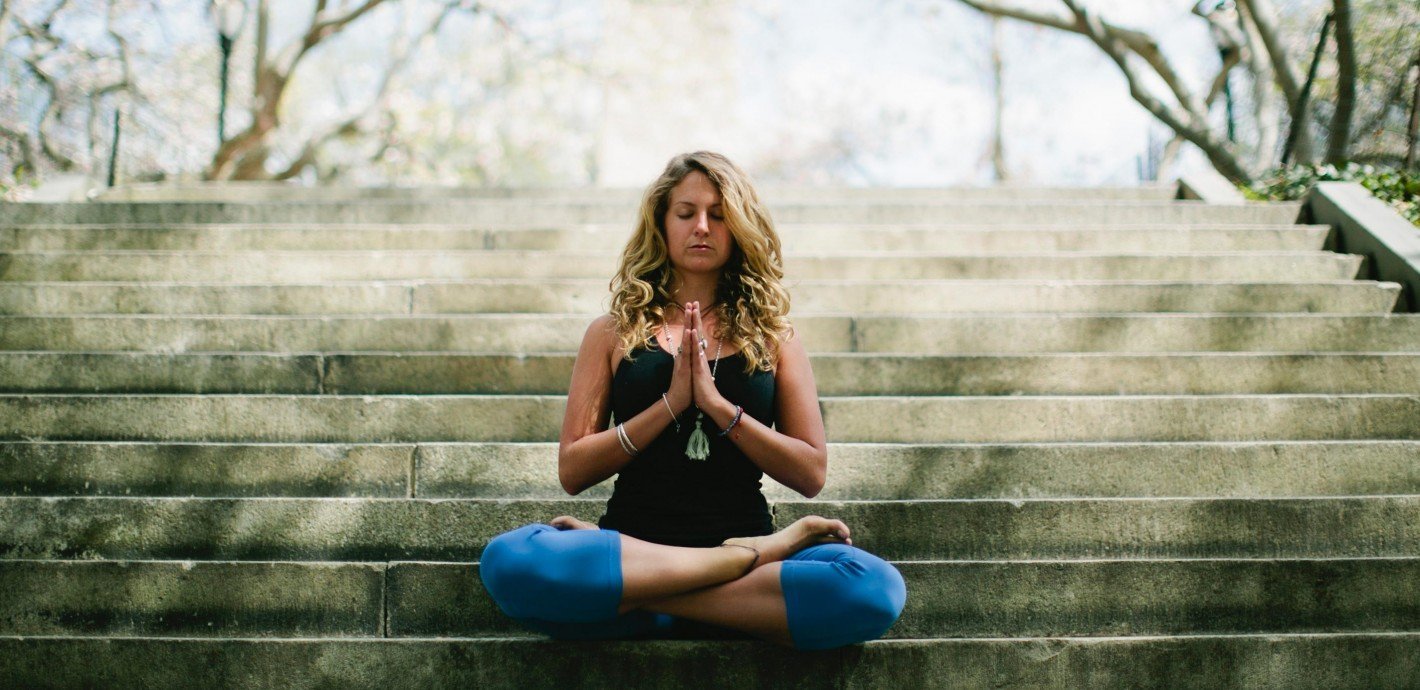There are a million forms of meditation in the world, but if you went around the world taking photographs of people meditating many of them would look quite similar. Why? Because there are some basic elements of the meditation posture that are employed across the globe in order to calm the mind and align the body.
I come from a Tibetan Buddhist background, so the framework I typically employ is the seven points of Vairocana. The Buddha Vairocana is often represented sitting in this posture at the center of a mandala of the five principle Buddhas. He is the lord of the buddha family, all white representing the wisdom of all-encompassing space, as well as it’s exact opposite, the very ignorance that is the driving force behind our cycle of suffering. He represents, in part, the idea that our ignorance can be transformed into vast spaciousness, which can accommodate everything. Not a bad role model, right?
The First Point of Posture: Sitting Down
For those of us who are accustomed to sitting in a chair, you might be a bit intimidated by the notion of sitting on the ground in a cross-legged fashion. This is a good time to give it a try. If you find that it is difficult, you can assume one of the simpler cross-legged postures I mention below.
There are a few variations on sitting cross-legged on the ground, but all of them are best supported by having a formal meditation cushion. I’m partial to those sold at Samadhi Cushions as their seats are well-made and firm. It is worth the investment to purchase a cushion if you’re going to launch a consistent meditation practice. And if you are going to use pillows from your couch or bed that’s okay, but it takes a lot of adjustment to get you sitting high enough so that it’s not painful. That said, if you want to grab some sturdy cushions and sit on those to get going, go for it.
The quarter lotus: Here you can sit on your meditation seat with your legs loosely crossed and both feet sitting below the opposite thigh or knee. I recommend this method
The half lotus: A variation on the above, your legs are crossed with one foot resting on the opposite thigh and the other foot laying underneath.
The full lotus: Your legs are crossed with both feet up on your opposite thighs.
The Burmese position: If you cannot sit with your legs crossed that’s fine. Just sit with both feet laying on the floor.
Seiza: Instead of sitting with your legs crossed you can also kneel on a bench or by placing a cushion between your legs.
Chair: Finally, yes, you can use a chair if you need to. No shame in it. Just be sure to sit away from the back of the chair and place your feet firmly on the floor, aligned with your hips and knees.
Sometimes people ask if they can meditate laying down. You can, but you’re more likely to fall asleep. If you’re going to do that you could place your feet on the ground with your knees up in order to maintain a sense of awake.
The Second Point of Posture: Elongate the Spine
Having established this firm foundation it is important to lift yourself up through your spine. Traditional analogies say that your spine should be like an arrow or a stack of coins, one on top of the other. It is as if a rod could go through the top of your head and down through your bottom. You want to feel uplifted when you sit down to meditate.
The Third Point of Posture: Resting Your Hands
The simplest thing to do with your hands is to rest them on your lap. You can drop your hands at your sides and pick them up at the elbow then drop them palms down on your thighs. This is a natural axis point on which to rest them, providing better support for your upright spine. In his new book The Relaxed Mind, Kilung Rinpoche mentions that sitting with your palms down tends to relax the flow of energy throughout your body.
Alternatively, you can place your right hand on top of your left with your thumbs very lightly touching, resting them on your lap at your navel. Kilung Rinpoche has remarked that this creates more heat and energy in the body, which can be useful if you are feeling sleepy. Symbolically, the left hand represents wisdom and the right compassion. In this gesture you are bringing the two together.
The Fourth Point of Posture: Relaxing the Shoulders
Let the muscles in your shoulder and back relax. Your shoulders can be pushed slightly back. This establishes a strong back while opening up the front body. There is a touch of vulnerability in this point of posture as we expose our tender heart.
The Fifth Point of Posture: Tucking in the Chin
Slightly tuck in your chin. You don’t want to go so far that you are looking directly down at your lap but you don’t want your head held so far upwards that it may tire you out.
The Sixth Point of Posture: Opening the Jaw
Bring a sense of relaxation to the muscles in your face so that your jaw hangs open. Place the tongue up against the roof of your mouth to allow for clear breathing and slow down the swallowing process, which can at times be distracting.
The Seventh Point of Posture: Resting the Gaze
Relax your gaze two to four feet ahead of you on the ground in an unfocused manner. Don’t pick out patterns in the rug in front of you. Just maintain a loose gaze. Rest your eyes. Sometimes people do not understand why they should open their eyes during meditation. For one, we are always gazing at our world—why should we treat our meditation practice as a time to hide from our life? It is instead a time to look directly at who we are. So our eyes can be open as a gesture toward that intention. On a practical level, you are less likely to fall asleep with your eyes open.
If you are unable to meditate with the eyes open you can close them. It is important to make a conscious decision before beginning to meditate on which you will do or you will fidget back and forth the entire meditation session between those options. It has been said that closed eye meditation leads to more thoughts, daydreams, and distraction. But if this is not the case for you, you can certainly meditate with your eyes closed.
If you take the time to establish your meditation posture correctly, you will find it is much easier to rest your mind and connect with the object of your meditation. When you go through these seven points you will enter your practice feeling relaxed yet uplifted.
Photo by Hailey Wist; Outfitted by Lolë Women








Comments (2)